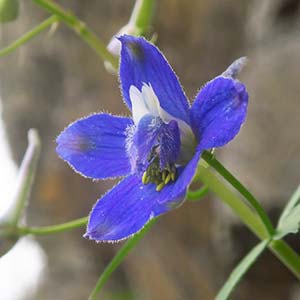Delphinium bicolor
Delphinium basalticum
Flathead larkspur, little larkspur, low larkspur, Montana larkspur
basalt larkspur, basaltic larkspur, Columbia Gorge larkspur
10-40(-70) cm;
base often reddish, glabrous to puberulent.
20-50(-65) cm;
base often reddish, puberulent.
blade round, 1-4 × 1.5-7 cm, glabrous to puberulent; ultimate lobes 3-19, width 1-8 mm (basal), 1-3 mm (cauline).
blade round, 2-6 × 5-9 cm, not succulent, nearly glabrous; ultimate lobes 5-19, width 3-15 mm (basal), 1-12 mm (cauline).
3-12(-22)-flowered;
pedicel 1-4(-8) cm, ± puberulent;
bracteoles 2-7(-17) mm from flowers, green, sometimes white-margined, lanceolate, 4-6(-8) mm, puberulent.
(2-)6-16(-26)-flowered;
pedicel 2-7 cm, nearly glabrous;
bracteoles 4-12 mm from flowers, green, linear, 3-7 mm, nearly glabrous.
sepals dark blue, puberulent, lateral sepals usually spreading, 16-21 × 6-12 mm, spurs straight to gently decurved, ascending 0-40° above horizontal, 13-23 mm;
lower petal blades covering stamens, 7-12 mm, clefts 0.1-3 mm;
hairs sparse, short, mostly on inner lobes below junction of blade and claw, white or yellow.
sepals dark blue, nearly glabrous, lateral sepals spreading, 15-21 × 7-10 mm, spur straight to decurved, ascending 30-45° above horizontal, 14-18 mm;
lower petal blades slightly elevated, ± exposing stamens, 7-9 mm, cleft 4-5 mm;
hairs centered, mostly on inner lobes above base of cleft, yellow to white.
(12-)16-22 mm, 4-4.5 times longer than wide, usually puberulent.
12-17 mm, 3.5-4 times longer than wide, glabrous.
often winged;
seed coat cells with surfaces ± smooth.
± wing-margined;
seed coat cells with surfaces smooth.
Delphinium bicolor
Delphinium basalticum
Subspecies 2 (2 in the flora).
Delphinium bicolor is closely related to D. glareosum; it differs in its wider-lobed cauline leaves, shallower petal clefts, and narrower fruits.
The Gosiute consider this plant to be poisonous (D. E. Moerman 1986, subspecies not specified).
(Discussion copyrighted by Flora of North America; reprinted with permission.)
Of conservation concern.
Hybrids between Delphinium basalticum and D. trolliifolium are known.
(Discussion copyrighted by Flora of North America; reprinted with permission.)
1. Sepals (especially in fresh material) dark blue to purple; cleft in lower petals 2 mm or less; soils not derived from limestone. | subsp. bicolor |
1. Sepals (especially in fresh material) bright dark blue; cleft in lower petals at least 2 mm; soils derived from limestone. | subsp. calcicola |


